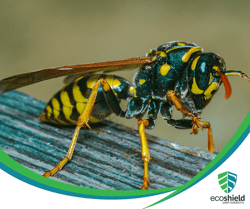Have you ever thought about the seasonal patterns of yellowjackets and hornets and how temperature affects their presence in your outdoor spaces? As the seasons change, so does the behavior of these stinging insects. In this blog post, we will address the confusion surrounding the temperature thresholds at which yellowjackets and hornets meet their demise, helping you better understand when you might encounter fewer of these buzzing pests around your home. Whether you're planning outdoor gatherings, gardening, or simply looking to enjoy your backyard in peace, knowing when these insects are inactive can be invaluable information for a pest-free environment.
Can Yellowjackets and Hornets Survive Freezing Temperatures?
Yellowjackets and hornets, like many other insects, are cold-blooded. This means their body temperature is heavily reliant on their surrounding environment. Their ability to survive freezing temperatures largely depends on the species, their life stage, and perhaps most importantly, the severity and duration of the cold conditions.
During the colder winter months, most yellowjackets and hornets do not survive freezing temperatures. These insects are simply not adapted to withstand extreme cold. Their nests, often located in underground burrows or paper-like structures, provide some limited insulation, but it's typically not enough to protect them from harsh winter extremes. As temperatures drop, the insects become sluggish, and their metabolism begins to slow down. Eventually, they enter a state of dormancy, essentially becoming inactive in a hibernation-like state. According to the University of Illinois, when temperatures drop below roughly 45°F for a period of 5-7 days or longer, their bodily fluids can freeze, ultimately leading to their demise.
It's important to note that not all yellowjacket and hornet species have the same cold tolerance. Some species, like the European hornet (Vespa crabro), have been observed surviving mild winters by huddling together in their nests to conserve heat and energy. On the other hand, some species, such as the Eastern yellowjacket (Vespula maculifrons), are less cold-tolerant and are more likely to succumb to freezing temperatures. Still yet, in some regions with mild winters, such as parts of the southern United States (e.g., Florida, Texas, and California), hornets and yellowjackets may remain active throughout the year. The cold temperatures in these areas are not severe enough to force these insects into hibernation or inactivity, meaning you can expect to see them year-round.
In addition, the queen yellowjacket or hornet plays a critical role in the survival of the colony through the winter. She is typically the only individual who survives the cold season by finding a protected site, such as a crevice in a tree or a wall void, where she enters a state of hibernation. In the spring, she emerges and begins building a brand new colony. If the queen dies during the winter, the entire colony will also perish.
In conclusion, while yellowjackets and hornets are generally not adapted to survive freezing temperatures, the ability to do so can vary among species and depends on the presence of a viable queen for colony regeneration. Nonetheless, the majority of these stinging insects do not endure extreme cold, which can be a relief for homeowners looking for respite from these pests during the winter months.
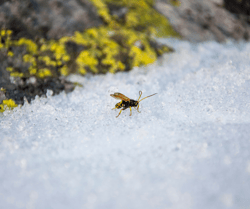 During the colder winter months, most yellowjackets and hornets do not survive freezing temperatures.
During the colder winter months, most yellowjackets and hornets do not survive freezing temperatures.
Can I Get Stung in the Fall or Winter?
The chances of getting stung by bees, wasps, or other stinging insects in the fall or winter is generally considered to be lower compared to the warmer months, but it is not entirely impossible. Here are some factors to consider:
- Reduced Activity: In the fall and winter, many stinging insects, including bees and wasps, become less active as temperatures dip. They are cold-blooded insects, and their metabolism slows down in cooler weather. As a result, their foraging and hunting activities greatly slow, which reduces the chances of encountering them as a homeowner. However, it's essential to note that not all species of stinging insects react the same way to colder temperatures. Some may remain active longer than others, particularly on milder days.
- Protection: As temperatures drop, stinging insects tend to seek shelter in their nests or hives. They become less aggressive and are more focused on preserving the colony. This means that unless you accidentally disturb their nests or provoke them, they are less likely to sting you. It's crucial to be cautious when working outdoors during the fall and winter, as disturbing a hidden nest can result in stings.
- Late-Nesting Species: Some species, like yellowjackets, may establish nests later in the year. If you come across a late-nesting colony in the fall, there is a higher risk of being stung if you get too close or disturb them. It's essential to remain vigilant and identify potential nesting sites, such as holes in the ground or building structures, to avoid any unexpected (and painful!) encounters.
While the risk of getting stung by stinging insects decreases in the fall and winter due to reduced activity and colder temperatures, it is not entirely impossible. To minimize the chances of stings during these seasons, we recommend that you stay cautious when working outdoors, be aware of your surroundings, and take preventive measures to keep these insects at bay.
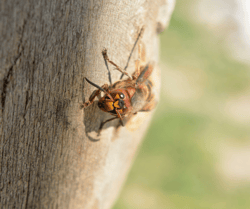 If you come across a late-nesting colony in the fall, there is a higher risk of being stung if you get too close or disturb them.
If you come across a late-nesting colony in the fall, there is a higher risk of being stung if you get too close or disturb them.
Where Do Yellowjackets and Hornets Go in the Winter if They Don’t Die?
In areas where yellowjackets and hornets do not die off during the winter, such as milder regions with relatively temperate climates, their behavior remains quite different from their counterparts in colder areas. While they don't experience the same dormancy (or death) as those in colder climates, their activities do change to adapt to the changing seasons.
During the winter months in these regions, it is typical for yellowjackets and hornets to become less active. As temperatures drop, their metabolism slows down, leading to a reduction in foraging and hunting activities. Their primary focus during this time is on the survival and maintenance of the colony rather than aggressive foraging for food. Nectar and honeydew from plants become more important food sources when fewer insects are active.
The nests of yellowjackets and hornets in temperate regions often provide some insulation and adequate protection from the elements. They may cluster together inside the nest to conserve heat and energy. The colony's size can also decrease as worker yellowjackets die off naturally due to aging. In these regions, the colonies may continue to exist throughout the winter, with the queen and fewer workers and males. When spring arrives and temperatures warm up, their activity levels increase, and they become more noticeable to homeowners as they prepare for the breeding season.
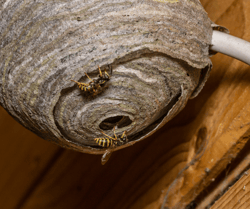 Yellowjackets and hornets may cluster inside their nest to conserve heat and energy.
Yellowjackets and hornets may cluster inside their nest to conserve heat and energy.
Can Yellowjackets and Hornets Survive Extreme Heat?
Yellowjackets and hornets, like many insects, are sensitive to extreme heat, and it can impact their behavior and survival in a variety of ways. As we know, stinging insects are cold-blooded, meaning their body temperature is regulated by the surrounding environment. As a result, extremely high temperatures can have some significant adverse effects on their physiology and behavior.
One notable response to extreme heat is reduced activity. Yellowjackets and hornets may become sluggish and less active in such scorching conditions. They often seek shade and shelter during the hottest parts of the day to avoid direct exposure to sunlight and excessive heat. This can lead to fewer encounters with humans during extreme heat waves as they prioritize self-preservation and the survival of their colony.
Furthermore, extreme heat can influence their nesting behavior. These insects typically construct nests in well-protected locations, and high temperatures can impact their ability to maintain optimal living conditions within the nest. Excessive heat can disrupt the delicate temperature and humidity regulation that is essential for the survival of the colony. In some cases, it can lead to the abandonment of nests, especially if the heat makes it challenging to rear larvae and maintain the nest structure.
While yellowjackets and hornets may exhibit resilience under varying environmental conditions, extreme heat is generally detrimental to their survival and activity. Though hotly debated, the National Institute of Health maintains that temperatures over 114°F may be enough to kill off hornets and yellowjackets if they are exposed to such extreme heat for extended periods of time. That said, thermal tolerance is highly dependent on the specific species of stinging insect.
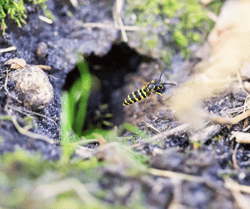 They often seek shade and shelter during the hottest parts of the day to avoid direct exposure to sunlight and excessive heat.
They often seek shade and shelter during the hottest parts of the day to avoid direct exposure to sunlight and excessive heat.
Can EcoShield Help Prevent Yellowjackets and Hornets Year-Round?
Yes! EcoShield offers year-round protection against all stinging insects, including the notoriously aggressive yellowjacket and painful hornet. We highly recommend homeowners in both warmer and cooler climates to safeguard themselves and their families from yellowjackets and hornets all year, not just during the summer months. To prevent or treat yellowjackets and hornets in or around your home, give EcoShield a call or fill out the form on this page today.
